The first thing people usually notice when they cross the gate of a suburban area or private property is the garden path.
The need for arrangements
It provides not only an aesthetic appearance of the landscape, but also allows you to conveniently use the territory. After all, it is not always pleasant to walk on the grass, wet from the rain, or on clay soil. DIY garden paths at low cost can be done with ease. However, first you need to decide on the design features of this element.

Varieties
In different areas you can find all kinds of tracks, based on different materials. If we talk about garden paths, they are a natural element of the territory. They are not specially planned - usually they are simply tamped down with their feet or compacted with garden equipment. If you decide not to make garden paths with your own hands, the shapes of which can be very diverse, but simply leave the trampled path, then you shouldtake into account all its disadvantages. Among them are the formation of mud after heavy rain, overgrowing with weeds, as well as constant puddles. Therefore, such an element can only be used temporarily. If there is a desire, the trail can be ennobled, for this, cobblestones, curbs or paving slabs, which remained from laying the parking space, are laid along the edges.
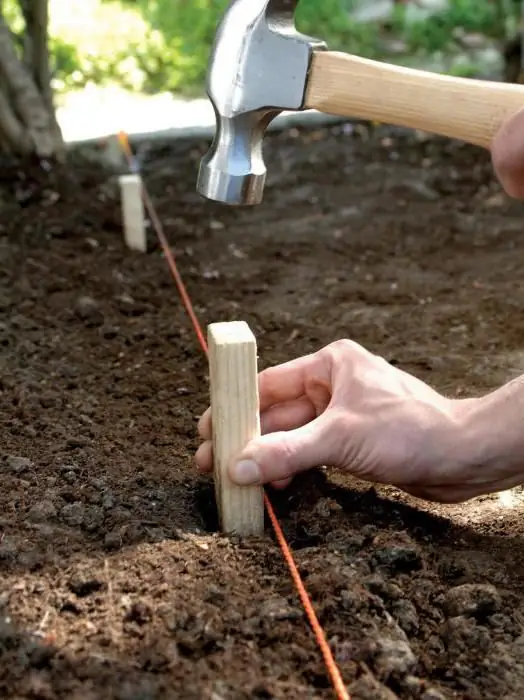
Tracks with base
If you equip garden paths with your own hands, it is possible to carry out these works at low cost. To do this, the above-described kind of path should be somewhat modernized. At the initial stage, a ditch breaks out, the depth of which is 100 millimeters. At its bottom, geotextiles should be laid, the density of which is 150 grams per square meter. The sides of the canvas can be reinforced with a border tape. Now pebbles, screenings, marble chips or crushed stone will be used, depending on what you have left after building the house. One of these materials must be poured to the bottom. If this option seems too simple, then slabs of natural stone or concrete can be laid on the surface, which can be arranged in an orderly or random manner. In order to ensure ease of movement, the slabs must be recessed into the backfill. Thus, these materials should end up flush with the ground.
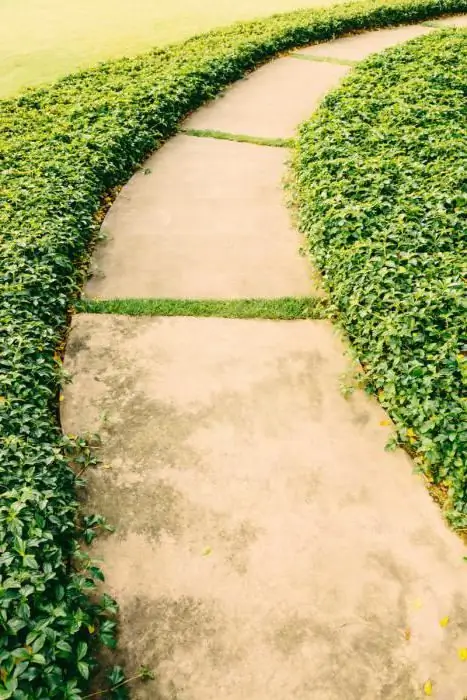
Fill paths
If you want to postdo-it-yourself garden paths at low cost, then you should definitely think about what loads the surface will undergo during operation. If they turn out to be impressive, then it is important to make the coating as durable as possible. At the same time, the base must be concrete, while decorative elements in the form of natural stone, tiles or paving stones will have to be laid on the surface. Well, if you have all these materials available, this will eliminate the purchase of a new coating and give free rein to your imagination. As a result, the territory of the site will acquire a natural look. When arranging an object, it is best to carry out manipulations in such a way that the surface rises above the ground by 70 millimeters. This will prevent soil sediment from being washed away by precipitation.

Making a path from wood cuts
If you want to equip garden paths with your own hands from tree cuts, you can make the path the most budgetary and attractive in appearance. Today, this approach is considered very popular. In addition to saw cuts, you can use wooden bars. If you have to work in a dry climate, then it is permissible to use not only wooden bars, but also thick boards, which can be purchased at a low cost in a building materials store. It is best to opt for hard rocks. To carry out the work, it is necessary to prepare segments of the same length, this figure should be equal to 100 centimeters. Width and thickness should beequivalent to 30 and 20 cm respectively. Next, the blanks are laid on sand or gravel.
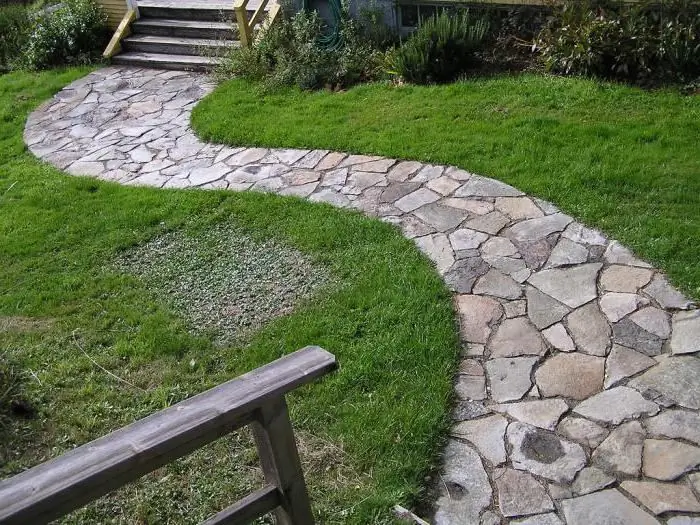
Features of the work
If you make garden paths using this technology with your own hands, reviews should be considered in advance. Home craftsmen emphasize that when using bars, they must be treated with fuel oil or a special substance that can protect the material from decay and moisture. For this, liquid asph alt can be applied to the underground surface of the bar, in some cases traditional sand preparation is arranged instead. If you decide to use such a combined coating in your work, then it is recommended to start and carry out the process in the fall, this is due to the fact that in winter the soil subsides, due to this you will be able to achieve natural tamping.
If there are fallen old trees on the territory, then you can make an excellent path out of them. DIY garden paths can be formed at low cost. To do this, the trunks must be sawn into separate parts, and the resulting elements, which will be saw cuts, should be used when carrying out manipulations. Equally well, such an exterior element will look near flower beds or near the lawn. Not only thick trunks, but also massive branches can be used in the work. With saw cuts formed from them, it will be possible to fill large elements. If you decide to make garden paths with your own hands at low cost,the dimensions of such elements must be thought out in advance. However, it is also important to observe the technology of work. In order to extend the shelf life of wooden products, they are treated with hot drying oil from all sides. This procedure should be carried out in two approaches. Between the saw cut and the ground, it is necessary to lay a geotextile sheet, which is sometimes replaced with polyethylene.
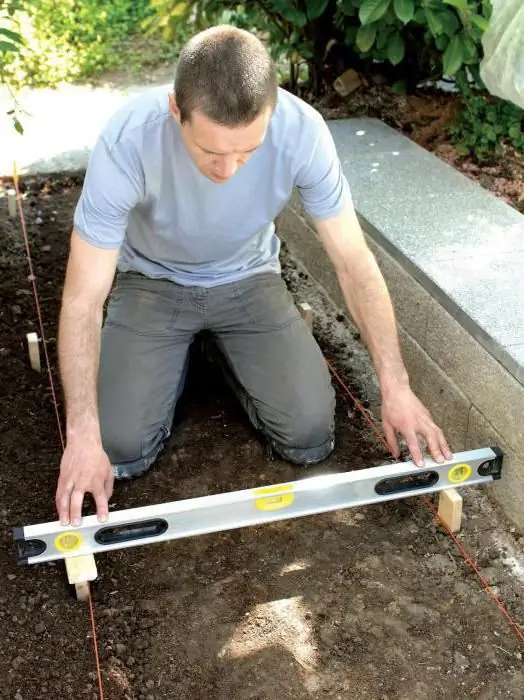
Arrangement of a path from paving slabs
Quite often, the owners of private and country houses have paving slabs after arranging a parking space for a car. In order to use any materials on the farm, excluding their accumulation in the barn, you can use these products to equip a functional garden path. For work, you should prepare a wooden mallet, pegs, a building level, a rake, a watering hose, a manual tamper, a rubber mallet, a trowel, a rope, a broom, and a channel.
The example uses paving slabs that are 50 or 60 millimeters thick. You can use a curbstone for these purposes, which will further ennoble the appearance of the path. Prepare crushed stone, the fraction of which can vary from 20 to 50 millimeters. It also often remains after construction work.
Do-it-yourself garden paths from improvised materials, the photos of which are presented in the article, are made using a building dry mix for plaster, which can be replaced with cement grade M400 or M500. Needgeotextile and sand.
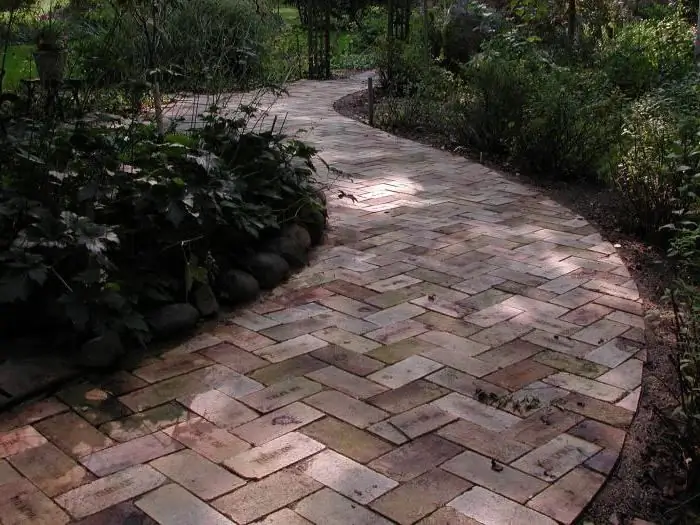
Work technology
The first step is to plan. It involves the creation of a scheme, the determination of the laying method and the shape of curly products. The next step is to markup. If you want to ensure correct installation, then it will be important for you to carry out these actions with the highest accuracy. To do this, use a rope, tape measure and pegs.
DIY garden paths from improvised materials, the photos of which are presented in the article, are made using marking tools, this will correctly determine the boundaries of the future path. After the markup is completed, the base should be prepared. To do this, the soil is cut to a depth of 20 cm. If the soil is clayey, drainage may be required.
The next step is to create a gravel or sand cushion. You will also need to pour a concrete screed. Geotextiles are laid between crushed stone and sand, which makes the structure more durable. When garden paths are equipped with their own hands from improvised materials, then using paving slabs, you need to lay the top layer, which will consist of a dry building mix. It can be prepared independently using cement and sand. The layer of the mixture should have a thickness within 4 cm. The surface is well leveled with a channel and a rake.
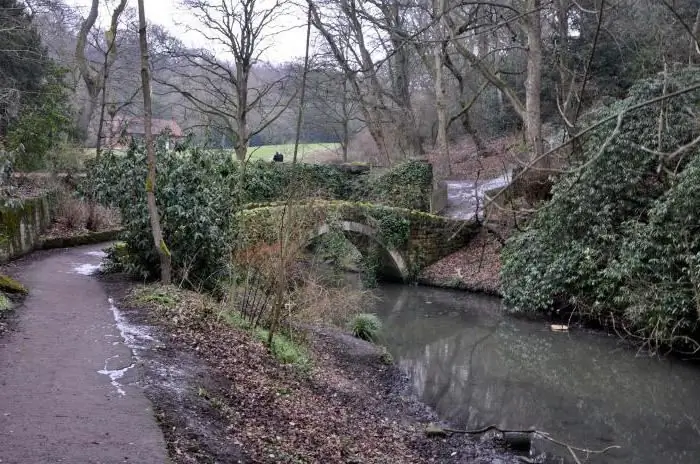
Laying tiles
When installingpaving products must be moved away from you, which will prevent damage to the laid base. Products should be mounted most tightly, the gap between them should be equal to 2 millimeters. Each product must be rammed with a wooden mallet. When garden paths are made with their own hands, the forms of such elements of a landscape plot can be very diverse. However, the surface must be level with the building level. Use a rubber mallet to adjust individual elements. First, you should use whole products, only after you need to lay the missing elements.
Concrete walkway
If you want to lay out garden paths with your own hands at low cost from concrete, then the preparation of the base should be carried out according to the technology described above. However, after laying the pillow, it is necessary to install the formwork, as well as lay the reinforcement. Next, the concrete solution is poured, as well as the leveling of its surface. In the process of drying the monolith, it is necessary to cover it with a wet burlap and water it every day. This is especially true for those tracks that were built during hot weather.
Plastic bottle path
DIY garden paths can be made from plastic bottles. To do this, use the technology that was described above. We are talking about wooden saw cuts. The process remains the same, but instead of wood, plastic containers will be used, which are installed upside down. As a result, it is possible to obtain a track with a very unique externalview.






